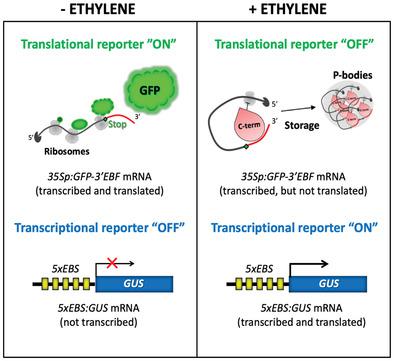当前位置:
X-MOL 学术
›
Small Methods
›
论文详情
Our official English website, www.x-mol.net, welcomes your feedback! (Note: you will need to create a separate account there.)
Monitoring Ethylene in Plants: Genetically Encoded Reporters and Biosensors
Small Methods ( IF 12.4 ) Pub Date : 2019-07-11 , DOI: 10.1002/smtd.201900260 Josefina‐Patricia Fernandez‐Moreno 1 , Anna N. Stepanova 1
Small Methods ( IF 12.4 ) Pub Date : 2019-07-11 , DOI: 10.1002/smtd.201900260 Josefina‐Patricia Fernandez‐Moreno 1 , Anna N. Stepanova 1
Affiliation

|
Phytohormone ethylene regulates numerous aspects of plant physiology, from fruit ripening to pathogen responses. The molecular basis of ethylene biosynthesis and action has been investigated for over 40 years, and a combination of biochemistry, genetics, cell, and molecular biology have proven successful at uncovering the core machinery of the ethylene pathway. A number of molecular tools have been developed over the years that enable visualization of the sites of ethylene production and response in the plant. Genetically encoded biosensors take advantage of reporter proteins, i.e., fluorescent, luminescent, or colorimetric markers, to highlight the tissues that make, perceive, or respond to the hormone. This review describes the different types of biosensors currently available to the ethylene community and discusses potential new strategies for developing the next generation of genetically encoded ethylene reporters.
中文翻译:

监测植物中的乙烯:转基因报告基因和生物传感器
植物激素乙烯调节植物生理的许多方面,从果实成熟到病原体反应。乙烯生物合成和作用的分子基础已经研究了40多年,并且已经证明,生物化学,遗传学,细胞和分子生物学的结合成功地揭示了乙烯途径的核心机制。多年来,已经开发了许多分子工具,可以可视化工厂中乙烯的产生和反应部位。遗传编码的生物传感器利用报告蛋白(即荧光,发光或比色标记)来突显产生,感知或响应激素的组织。
更新日期:2019-07-11
中文翻译:

监测植物中的乙烯:转基因报告基因和生物传感器
植物激素乙烯调节植物生理的许多方面,从果实成熟到病原体反应。乙烯生物合成和作用的分子基础已经研究了40多年,并且已经证明,生物化学,遗传学,细胞和分子生物学的结合成功地揭示了乙烯途径的核心机制。多年来,已经开发了许多分子工具,可以可视化工厂中乙烯的产生和反应部位。遗传编码的生物传感器利用报告蛋白(即荧光,发光或比色标记)来突显产生,感知或响应激素的组织。



























 京公网安备 11010802027423号
京公网安备 11010802027423号